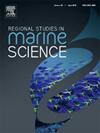波斯湾和阿曼湾帝王鱼(Teleostei: Lethrinidae)的分子系统学:对隐藏多样性的新认识
IF 2.4
4区 环境科学与生态学
Q3 ECOLOGY
引用次数: 0
摘要
皇帝鱼,Lethrinus Cuvier, 1829年,通常被认为是生态和经济上重要的鱼类,主要出现在印度洋-太平洋的珊瑚礁地区,包括波斯湾和阿曼湾。由于种间形态的细微差异,本属的系统分类学比较复杂。此外,由于分类群数量和地理分布的限制,对Lethrinus种遗传变异性的分子研究较少。为了实现这一目标,我们构建了一个强大的系统发育树,使用线粒体COI序列进行各种分子物种划分和系统地理分析,以确定系统发育关系,并揭示波斯湾和阿曼湾隐藏的物种多样性。我们的系统发育结果显示,在Lethrinus中有五个主要的分支,在节点处有中等到强烈的支持。我们的研究结果表明,存在至少四个未经证实的候选物种,这些物种得到了单倍型网络和多个分子物种划分的很好支持,这一发现与之前的分类分类相矛盾。这些结果表明,具有两个遗传上不同谱系的Lethrinus crocineus和具有至少三个进化上不同谱系的L. nebulosus代表了一个值得在物种水平上认识的隐种复合物。此外,还发现了L. lentjan作为第三个具有强健遗传结构的隐种。在波斯湾和阿曼湾的生态区内,发现了5种不同的系统发育谱系,这已被证明是地方性生物多样性的热点地区。本文章由计算机程序翻译,如有差异,请以英文原文为准。
Molecular systematics of the emperor fishes (Teleostei: Lethrinidae) from the Persian Gulf and Gulf of Oman: New insights into cryptic diversity
The emperor fishes, Lethrinus Cuvier, 1829, are generally considered to be ecologically and economically important fishes, occurring primarily in coral reef areas of the Indo-Pacific including the Persian Gulf and Gulf of Oman. The systematics and taxonomy of this genus are complicated due to subtle morphological differences among species. In addition, few molecular studies have investigated the genetic variability of Lethrinus species due to the limited number of taxa and restricted geographic distribution. To achieve this, we constructed a robust phylogenetic tree, various molecular species delimitations and phylogeographic analyses using mitochondrial COI sequences to determine phylogenetic relationships and reveal hidden species diversity in the Persian Gulf and Gulf of Oman. Our phylogenetic results revealed five major clades within Lethrinus with moderate to strong support at nodes. Our findings indicate the existence of at least four unconfirmed candidate species that are well supported by the haplotype network and multiple molecular species delimitations, a finding that contradicts previous taxonomic classification. These results suggest that Lethrinus crocineus, with two genetically distinct lineages, and L. nebulosus, with at least three evolutionarily distinct lineages, represent a cryptic species complex deserving recognition at the species level. In addition, L. lentjan was discovered as a third cryptic species with a robust genetic structure. Five distinct phylogenetic lineages in these complexes were observed in the ecoregions of the Persian Gulf and Gulf of Oman, which have been proven to be hotspots of endemic biodiversity.
求助全文
通过发布文献求助,成功后即可免费获取论文全文。
去求助
来源期刊

Regional Studies in Marine Science
Agricultural and Biological Sciences-Ecology, Evolution, Behavior and Systematics
CiteScore
3.90
自引率
4.80%
发文量
336
审稿时长
69 days
期刊介绍:
REGIONAL STUDIES IN MARINE SCIENCE will publish scientifically sound papers on regional aspects of maritime and marine resources in estuaries, coastal zones, continental shelf, the seas and oceans.
 求助内容:
求助内容: 应助结果提醒方式:
应助结果提醒方式:


